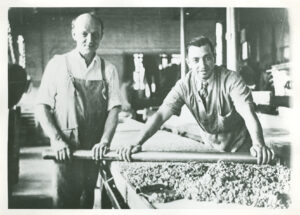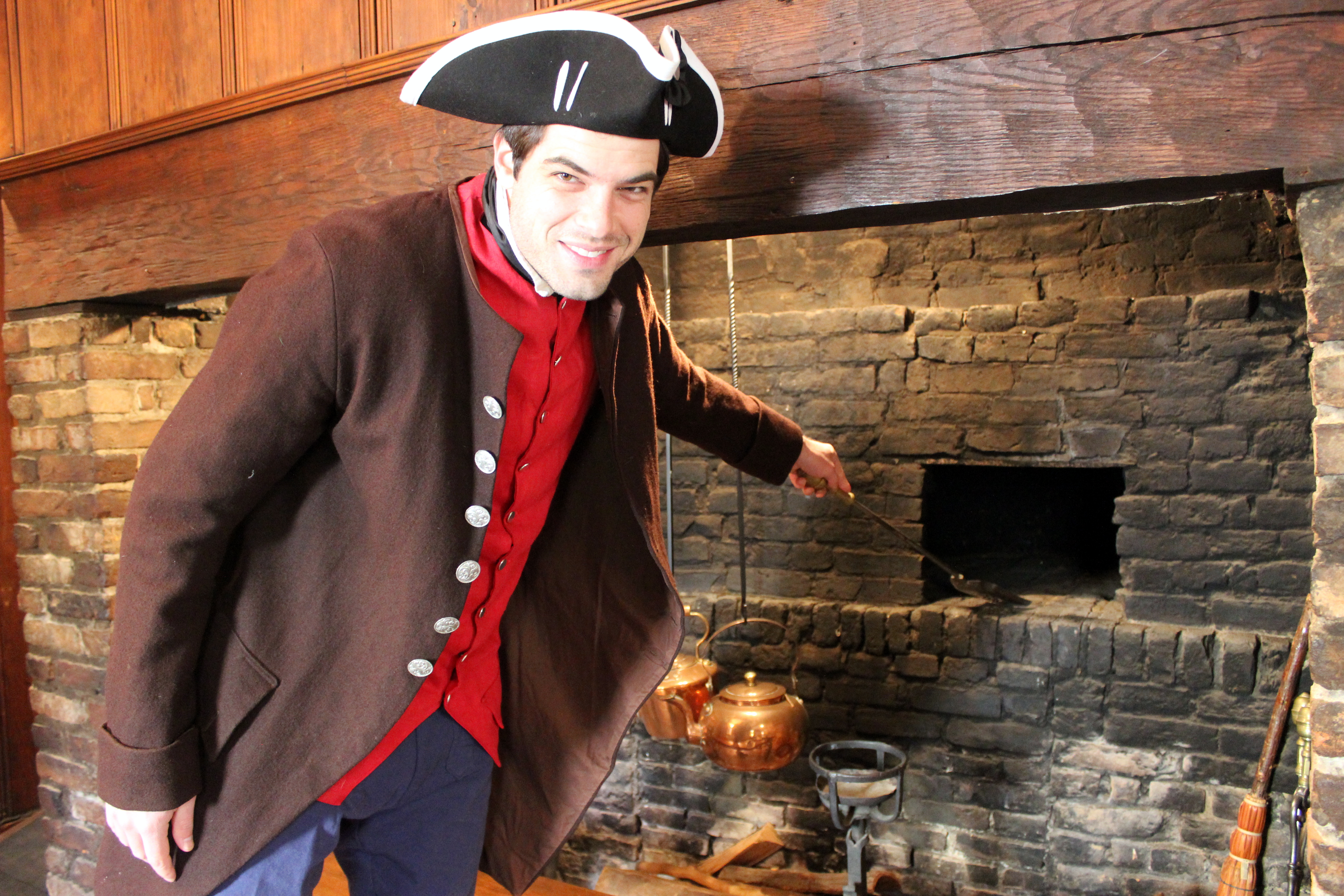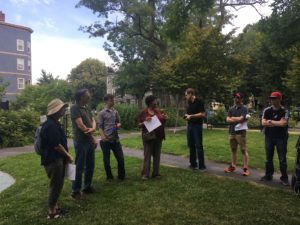Fort Washington, 1775-1975, and Other Cambridge Fortifications
By Douglas Payne Adams and Charles Sullivan, with an introduction by Charles W. Eliot, 2nd
Presented June 1, 1975
Mr. Eliot
Of the fortifications which were constructed in Cambridge two hundred years ago, a single battery—Fort Washington —still exists. Lieutenant-Governor Oliver had been forced to resign on September 2, 1774, and by the following spring—after the battles of Lexington and Concord—both the provincial and the continental armies were gathered in the encampment around Cambridge Common. General Artemas Ward had taken command of that “mixed multitude” of militia, minutemen, and volunteers, and set them to work on trenches, earthworks, and forts to protect the patriot encampment against possible attack by the British from Boston. The fortifications began at Fort # 1, located at Riverside on the Charles River between what is now River Street and Western Avenue; they were planned to control all access by river. They ran also from Fort #2 at Putnam Avenue and Kinnaird Street, up over “Butler’s Hill” (Dana Hill) and between Dana Street and Hancock Street, to Fort #5 at Broadway and Maple.
The entrenchments over Dana Hill are labelled “Cambridge Lines” on the famous Pelham Map made at that time.
Mr. Robert Nylander, who undertook the research for the Cambridge Historical Commission’s survey reports on the city’s architectural history, worked through the contemporary documents— military papers, diaries, and histories—to build up a remarkable record of our Revolutionary fortifications. He found that the Dana Hill fortifications, described by Drake as “six redans” joined by curtains (Samuel Adams Drake, Historic Mansions and Highways around Boston, Boston, 1899, p. 186), carried across the road (Massachusetts Avenue) and up the slope of Dana Hill, terminating at the north extremity in another redoubt situated on the crest, in an angle of Broadway and Maple Avenue on the Greenough estate. A hundred yards behind this line, another earth rampart rested on the main road (Massachusetts Avenue at Dana Street).
Other trenches and redoubts were constructed by direction of Artemas Ward before Washington took command in Cambridge. They may have included a revival of an early colonial fort which was originally located on Holyoke Place (where Lowell House now stands); almost certainly Fort #3; and the “citadel” on Prospect Hill in Somerville as well as “Brooklin Fort” at the south end of what is now the B.U. Bridge on Sewall’s farm, and other works in what is now Boston.
Washington improved and expanded these fortifications, first for the better protection of the Cambridge encampment, and then for the siege of Boston. These works included a battery near Franklin and Lansdowne Streets in Cambridge. On the strength of statements by both Frothingham and Paige, it seems probable that there was also a battery on Captain’s Island. Mr. Eliot persuaded the MDC engineers who were working on a restoration of the Magazine Beach Park to reconstruct a redoubt or earthwork there—whether authentic or not, we can only guess. Washington himself described the main effort in a letter to the Continental Congress, written on November 28, 1775:
I have caused two half moon batteries to be thrown up for occasional use, between Litchmore’s Point & the mouth of Cambridge River and another work at the Cause[wa]y going to Litchmore’s Point to command that pass, & rake the little rivulet that runs by it to Patterson’s Fort—besides these I have been & marked out three places between Sewall’s Point & our lines on Roxbury Neck for works to be thrown up, and occasionally mann’d in case of a sortie, when the bay gets froze.
George Washington to Joseph Reed, Philadelphia, November 27, 1775, MS. in John Carter Brown Library, Providence, R.I.
The Cambridge works referred to are Fort Putnam at the causeway to Lechmere Point in East Cambridge from which the bombardment of Boston began on March 5, 1776 and Fort Washington in Cambridgeport, the only surviving site of the American defenses in Cambridge.
Professor Adams
The Fort Washington battery had been the object of Professor Douglas Adams’s efforts for preservation over a fifty-year period. When he first came upon it, the fort was in a state of “utter wretchedness”: its earthworks, handsome cannon posts, and ornamental iron fence had been allowed to fall into neglect. City officials showed no concern for it, and the area was surrounded by warehouses, ugly factories, and a trucking company. For many years the Cambridge (Hannah Winthrop) chapter of the DAR had maintained lovely flower beds at the site. Gradually Professor Adams succeeded in enlisting the interest and support of individuals and organizations—Paul Dudley White and the Boy Scouts, Bernard Rudolph and the Jewish War Veterans in Cambridgeport, students at the Rindge Technical School, President Howard Johnson of MIT—to protect the fort from further depredations and neglect. With Mr. Eliot’s help, the site was placed on the National Register, so that it might be eligible for federal funds and would certainly be protected from obliteration by future highways. A crucial element in the campaign was the archaeological research which the Cambridge Historical Commission carried on at the site. Professor Adams, to his own satisfaction, had found the previously quoted letter from General Washington to Joseph Reed describing the fortifications which had been thrown up at the general’s orders. At the close of his letter, Washington asked that “If any Waggon should be coming this way, I say order a supply of good writing paper to Head Quarters; & Sealing Wax.” Clearly, Washington had found himself in the land of the barbarians.
Mr. Sullivan
Despite the current state of neglect of Fort Washington, concern for its preservation goes back to the period just after the Revolution. Immediately after the Siege of Boston, the fort passed to the estate of George Francis Dana, who was assembling property in Cambridgeport at that time. A charter had been granted for the West Boston Bridge, and interest in the development of Cambridgeport was high. The immediate area of Fort Washington, however, remained woods and fields, and the shore line was known for many years as “the oyster banks.” Dana died in 1822, and the property passed to his heirs, who began to see possibilities for development of that part of Cambridgeport as a residential suburb of Boston. In 1838, they hired Alexander Wadsworth, who had been surveyor of Mount Auburn Cemetery and of many residential subdivisions, to develop a plan for a residential suburb to be known as Pine Grove. Unfortunately, this was not a success. Pine Grove was off the beaten track, on a dead-end road with nothing beyond but the Commonwealth’s powder magazine; the Cottage Farm (Boston University) Bridge was not built until 1856. Following Wadsworth’s plan Fort Washington was laid out as an ornamental square, along with another square called Pultney Square. Sidney Willard, who had been a professor at Harvard, became a partner in the real estate development and built a house, of which there is no view remaining, on Washington Square. The fort must have been landscaped at that time; the few plans we have show it as an oval residential square.
Within fifteen years of the original subdivision, the handwriting was clearly on the wall. The Union Railroad obtained a charter in 1848 to run from Brighton through Somerville to East Boston, and construction began in 1853. The track actually cut across Washington Square, and the proprietors of the subdivision saw that it was never going to be the elegant area of freestanding, single-family, expensive houses that they had planned. In an attempt to recoup, they laid out Brookline Street, had the Cottage Farm Bridge constructed, and reorganized Pultney Square into the present Hastings Square. The proprietors sued the railroad for indemnity but agreed that any funds received should be appropriated for the beautification of the square. Two years later they conveyed Fort Washington to the city for one dollar, with conditions which have rarely been respected. The conveyance was made “upon the express conditions that the above released premises when suitably enclosed and adorned by the City, shall forever remain open for light, air, and ornament, for the convenience and accommodation of the owners of estates in said Pine Grove and of the public generally.” (Deed conveying Washington Square to the City of Cambridge, May 25, 1857)
The City of Cambridge took over immediately and contacted the secretary of war, the secretary of the navy, and the Massachusetts legislature. The commonwealth voted $2,000 if the city would match it for the ornamental fence and a flagstaff. The secretary of war gave three eighteen-pound guns from Fort Warren on Governors Island, and the secretary of the navy gave three gun carriages. The fence was designed by John R. Hall, an architect, and cast in Cambridge at a cost of $3,600. In 1858 the improvements were nearly completed, and according to the Chronicle it was then “a favorite resort on Sunday afternoon at sundown, with a view of the Blue Hills, Corey’s Hill, the white houses of Roxbury and the South Boston asylum, a fine western view of dome-crowned Boston . . . Bunker Hill, the heights of East Cambridge, and, at our feet, the River Charles.” (Cambridge Chronicle, September 11, 1858.)
After the Civil War, Cambridgeport became increasingly industrial, and the neighborhood of the fort became known as “Greasy Village,” after the rendering plant and soap factory across the street. In 1902 the Daughters of the American Revolution petitioned the city to restore the fence. It was restored again in 1928 and was thereafter neglected until Professor Adams arrived on the scene in the 1950s. The Commission now proposes to restore the fort for perhaps the fourth time, but this time enough money will be spent to protect it from further damage.
The restoration began in the summer of 1974 with an archaeological reconnaissance to locate the remains of any structures and to see if the earthworks were authentic. Two archaeologists from Harvard’s Peabody Museum found the earthworks to be in fact original, and discovered the remains of a wooden structure and a few traces of gunpowder. It seems that this may have been a powder magazine.
Since then the Historical Commission had convinced the city council to appropriate $26,000, applied to the Massachusetts Bicentennial Commission for $15,000 to match it, and asked the National Park Service for $41,000 to match the total. The restoration plan envisioned construction of a new iron fence duplicating the old; closing the paved area at the rear of the park, which had become a public way; protecting the new fence by a barrier to prevent further damage from the St. Johnsbury Trucking Company operations; and landscaping. If MIT carries out its intentions of eventually opening up the vista to the river, the park may gain a user population for the first time in perhaps a hundred years, and will once again have the kind of use that it was intended to have.
POSTSCRIPT
Work on the project envisioned in 1975 continued through 1978. Although a total of $105,000 was expended, that amount was not sufficient for completing the restoration of the entire fence and park.
From the Cambridge Historical Society Proceedings for the years 1973-1975. Volume 43, pages 141-146.






